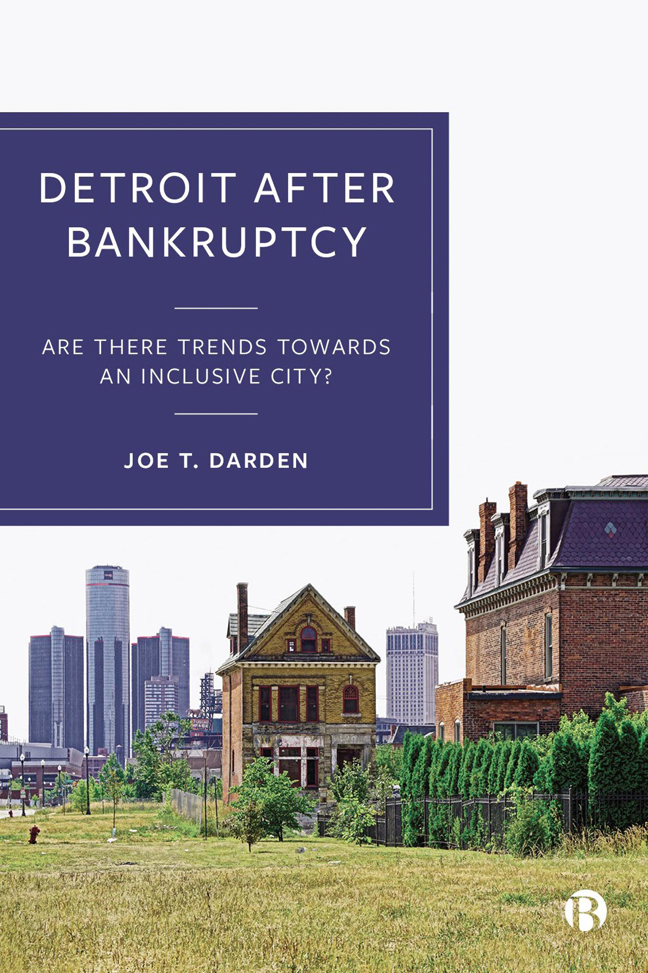Book contents
- Frontmatter
- Dedication
- Contents
- List of Figures and Tables
- Acknowledgments
- Preface
- 1 Antecedents to Bankruptcy
- 2 Detroit Bankruptcy: The Characteristics of the Decision Makers and the Differential Benefits Afterwards
- 3 The Postbankruptcy Social and Spatial Structure of Metropolitan Detroit: Anatomy of Class and Racial Residential Segregation
- 4 Gentrification: A New Method to Measure Where the Process Is Occurring by Neighborhood
- 5 The Uneven Distribution of Economic Redevelopment: Which Neighborhoods Are Excluded?
- 6 Black and Hispanic Underrepresentation in Business Ownership in a Majority-Black City
- 7 Racial Inequality in Student Academic Achievement Levels: A Neighborhood Solution to the Problem
- 8 Unequal Exposure to Crime in the City of Detroit: A New Method to Measure Exposure by the Characteristics of Neighborhoods
- 9 Solving the Problem of Extreme Race and Class Inequality: Implementing the Spatial Mobility Alternative
- 10 Conclusions: The Status of the Residents of Detroit after Bankruptcy
- References
- Index
3 - The Postbankruptcy Social and Spatial Structure of Metropolitan Detroit: Anatomy of Class and Racial Residential Segregation
Published online by Cambridge University Press: 25 January 2024
- Frontmatter
- Dedication
- Contents
- List of Figures and Tables
- Acknowledgments
- Preface
- 1 Antecedents to Bankruptcy
- 2 Detroit Bankruptcy: The Characteristics of the Decision Makers and the Differential Benefits Afterwards
- 3 The Postbankruptcy Social and Spatial Structure of Metropolitan Detroit: Anatomy of Class and Racial Residential Segregation
- 4 Gentrification: A New Method to Measure Where the Process Is Occurring by Neighborhood
- 5 The Uneven Distribution of Economic Redevelopment: Which Neighborhoods Are Excluded?
- 6 Black and Hispanic Underrepresentation in Business Ownership in a Majority-Black City
- 7 Racial Inequality in Student Academic Achievement Levels: A Neighborhood Solution to the Problem
- 8 Unequal Exposure to Crime in the City of Detroit: A New Method to Measure Exposure by the Characteristics of Neighborhoods
- 9 Solving the Problem of Extreme Race and Class Inequality: Implementing the Spatial Mobility Alternative
- 10 Conclusions: The Status of the Residents of Detroit after Bankruptcy
- References
- Index
Summary
Introduction
This chapter is based on my analysis of the social and spatial structure of the Detroit Metropolitan Area (DMA) postbankruptcy. It also examines racial residential segregation through socioeconomic neighborhood characteristics. For the purposes of this chapter, the study area consists of Wayne, Oakland, and Macomb Counties.
Such analysis allows for the measurement of racial residential segregation combined with inequality in neighborhood socioeconomic characteristics related to the racial composition of neighborhoods. To analyze these three counties for the purposes of determining the extent of inequality, I use census tracts from the American Community Survey Five-Year Estimates as spatial units, as they are surrogates for neighborhoods. Most of the analyses are based on data from the 2011–15 and 2016–20 Five-Year Estimates databases. I use the Darden-Kamel Composite Socioeconomic Index (CSI) to analyze Metropolitan Detroit (DMA) by neighborhoods in order to determine the extent of class inequality, and the index of dissimilarity to determine the extent of racial residential segregation and socioeconomic neighborhood inequality by race (Darden et al, 2010). The analysis of the data shows that the inequality gap between neighborhoods increased between the 2011–15 and 2016–20 censuses. This inequality has negatively impacted Black and Hispanic residents more than white residents as Black and Hispanic residents disproportionately reside in neighborhoods with very low and low socioeconomic characteristics. Most whites, on the other hand, reside in neighborhoods with high and very high socioeconomic characteristics. The data and analyses in this chapter answer questions about inequality after bankruptcy. Detroit is not moving toward a more inclusive city racially and socially. Both race and class inequality remain, and more actions need to be taken with policies to reduce the inequality. The implications of the data and analyses are that racial discrimination continues after bankruptcy.
Explaining the Darden-Kamel Composite Socioeconomic Index
The Darden-Kamel CSI incorporates nine variables:
1. Percentage of households below poverty
2. Unemployment rate
3. Median household income
4. Occupational status
5. Educational attainment
6. Median value of dwelling
7. Median rent of dwelling
8. Percentage of households that own homes
9. Percentage of households with a vehicle available
Definitions of the variables
1. Percentage below poverty: the percentage of all families whose income in the past 12 months is below the US poverty level.
- Type
- Chapter
- Information
- Detroit after BankruptcyAre There Trends towards an Inclusive City?, pp. 35 - 59Publisher: Bristol University PressPrint publication year: 2023



